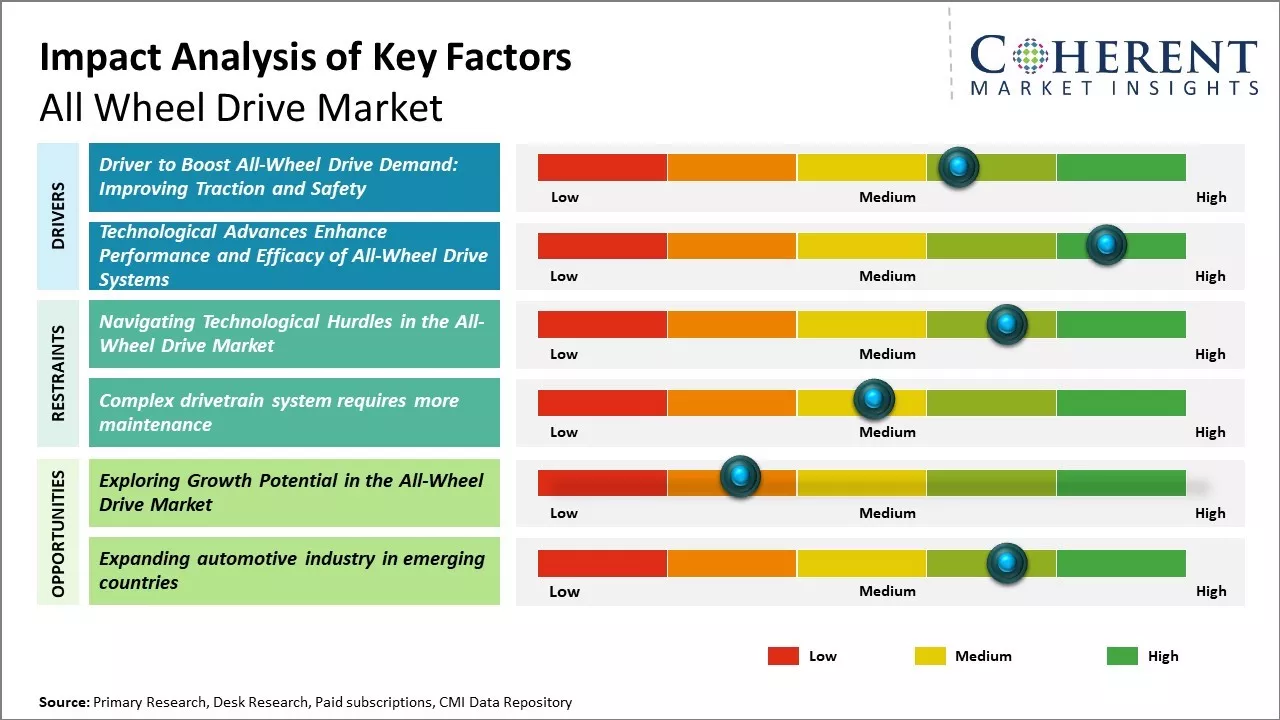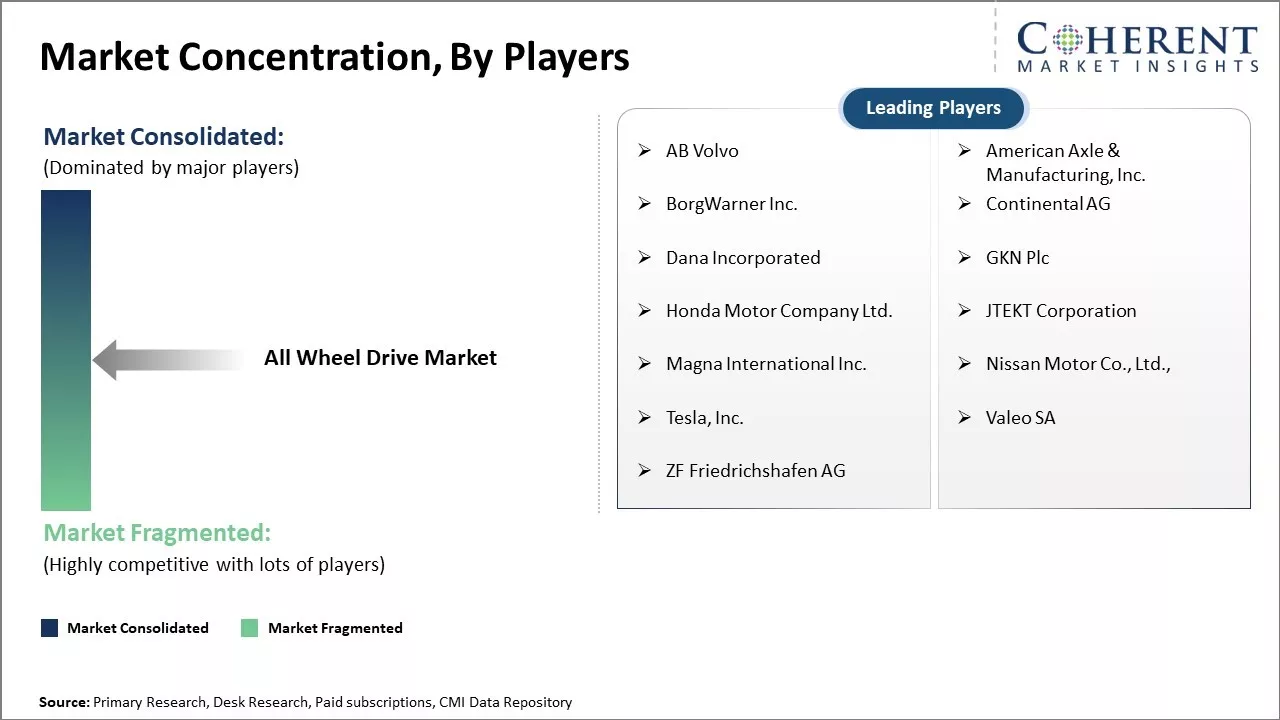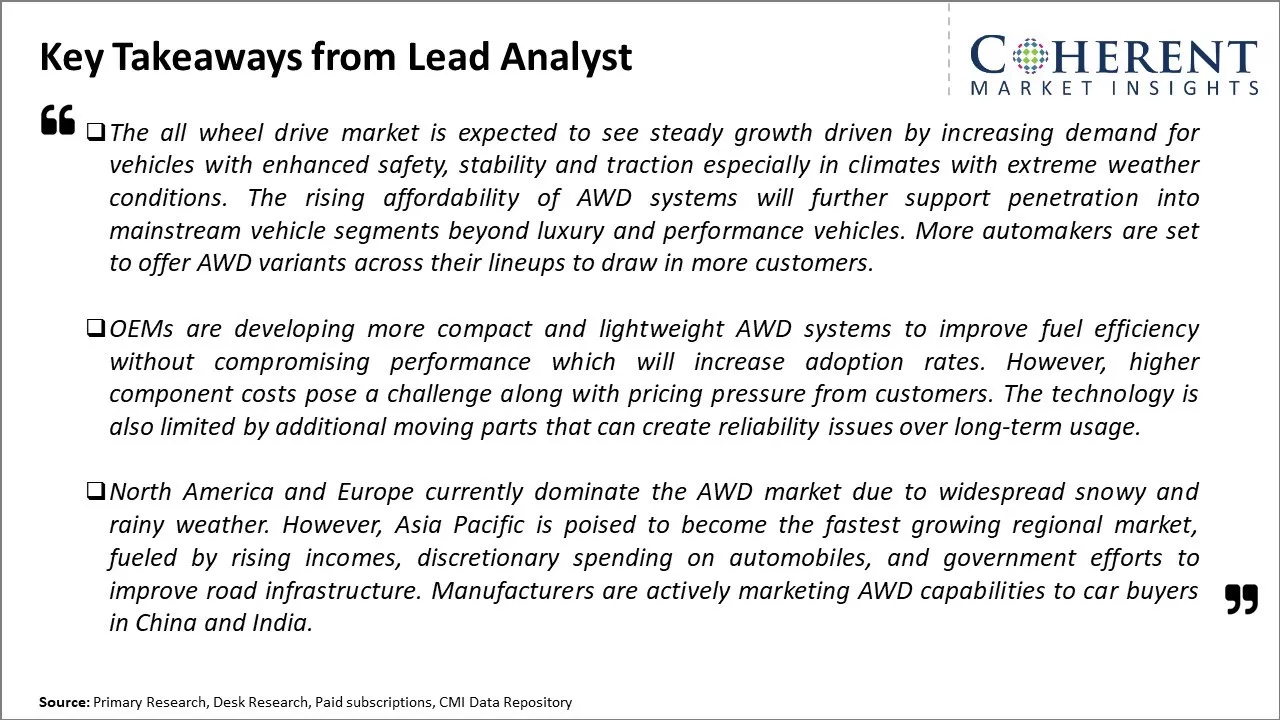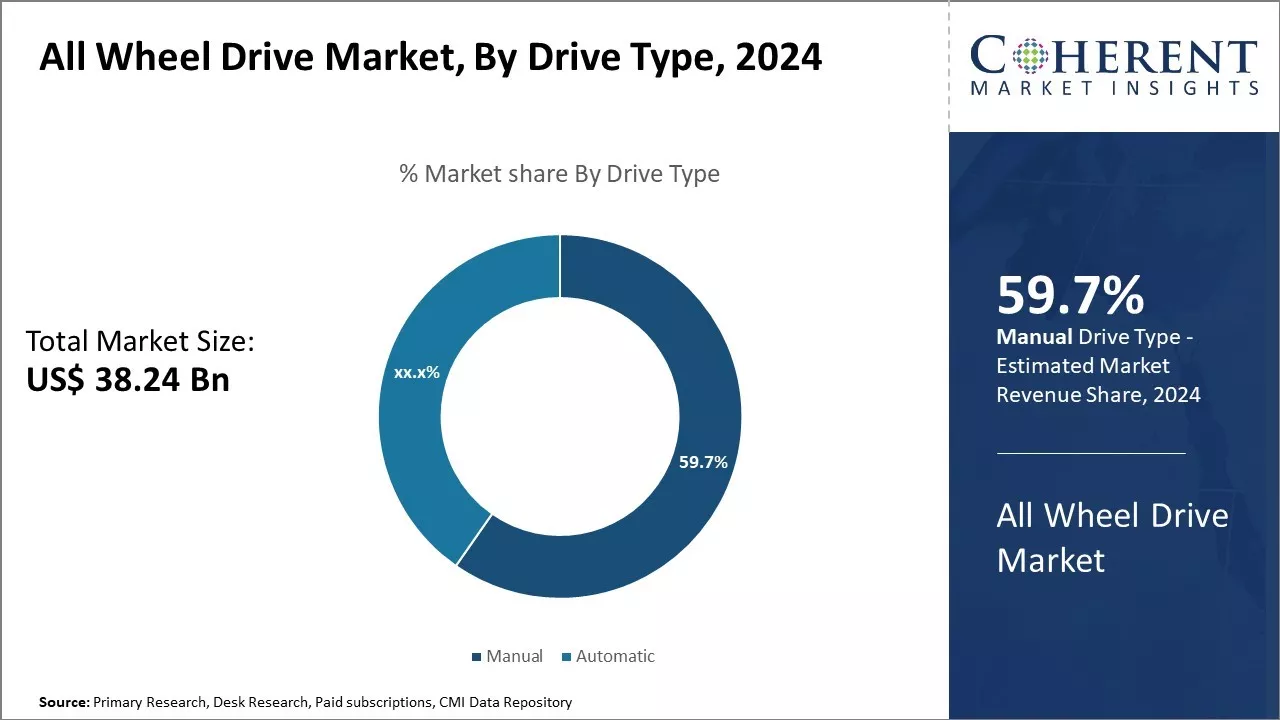Global all wheel drive market is estimated to be valued at US$ 41.34 Bn in 2025 and is expected to reach US$ 71.36 Bn by 2032, exhibiting a compound annual growth rate (CAGR) of 8.1% from 2025 to 2032.

Discover market dynamics shaping the industry: Request sample copy
The market has been witnessing consistent growth over the past few years due to rising demand for enhanced vehicle safety, stability and traction. With extreme weather conditions becoming more prevalent, consumers have started preferring all wheel or four wheel drive vehicles that offer improved handling on slippery surfaces. All major automobile manufacturers have been expanding their all wheel drive vehicle offerings especially sports utility vehicles and crossovers to gain larger share of the market. Rising demand for premium and luxury vehicles globally has a positive impact on sales of high performance all wheel drive cars. However, the technology adds to production costs which could limit the market growth.

Get actionable strategies to beat competition: Request sample copy
Improving traction and safety boosts demand for all wheel driveAll wheel drive (AWD) is gaining popularity among consumers seeking enhanced traction and safety benefits in their vehicles. With increasing concerns over road conditions like snow, rain or muddy terrain, AWD allows vehicles to maintain better control and stability even on slippery surfaces due to the sophisticated drivetrain that distributes torque to all four wheels for optimized traction and handling. The even weight distribution helps supplement a loss of traction on any single wheel. This becomes extremely useful in challenging conditions that are typically encountered during winters or off-road driving.
AWD also provides tangible safety benefits in certain scenarios. By powering all four tires, the system is able to deliver optimal acceleration and braking performance. This comes especially handy in emergencies like abrupt maneuvers needed to avoid an obstacle. The precise control and balanced weight transfer of an AWD vehicle allows it to hug narrow curves and corners much more securely than conventional rear-wheel drive models. With dangerous distractions on roads increasing each day, drivers are recognizing the safety net of advanced traction control that AWD offers. Many people are willing to pay extra to gain this peace of mind, thus, boosting demand for AWD.
Technological advancements enhances performance and efficacy of all wheel drive systems
While all wheel drive has been utilized primarily for enhanced traction, technological developments are increasing its adoption for performance benefits as well. Advancements in drivetrain mechanics and componentry have made modern AWD implementations highly sophisticated. Sophisticated torque vectoring and differential controls are able to precisely manage the distribution of power between the front and rear axles. This allows for optimized cornering, acceleration and braking characteristics under varying conditions. Some high-end luxury brands are outfitting performance-focused vehicles with advanced AWD technologies tuned for maximum handling and control even during spirited driving.
Another factor stoking performance interest is the increasing use of lightweight yet durable materials in drivetrain components. This enables engineers to design compact yet robust multi-plate clutch mechanisms and differentials for sophisticated on-demand AWD operation. Lighter weight also translates to improved fuel economy without compromising on the brand's performance pedigree. As technologies continue enhancing the capabilities of AWD while lowering its fuel consumption penalties, more drivers will likely gravitate towards the improved handling, safety and track abilities it affords.

To learn more about this report, Request sample copy
Market Challenges: Navigating Technological Hurdles in the All-Wheel Drive MarketThe all wheel drive market faces several technological challenges. Maintaining optimal traction and power distribution across all four wheels under varying road conditions requires advanced sensor technology and precise torque vectoring. The additional mechanical components needed for all wheel capability also increase vehicle weight and complexity, raising production costs. Feedback from some drivers suggests all-wheel systems can interfere with normal handling dynamics in dry conditions.
Market Opportunities: Exploring Growth Potential in the All-Wheel Drive Market
Despite the technical hurdles, the all wheel drive market provides opportunities for growth. As weather patterns become more erratic with climate change, consumer interest in vehicles with superior traction increases. All wheel models command pricing premiums that boost automaker revenues. With refinements to make all wheel drive systems lighter and less intrusive under normal driving, vehicle makers can access more market segments and expand sales in performance and luxury categories.

Discover high revenue pocket segments and roadmap to it: Request sample copy
Insights, By Drive Type- Convenience and control drive dominance of manual transmissionIn terms of drive type, manual segment is estimated to contribute the highest share of the market owing to advantages it provides users in terms of convenience and control. Those who prefer manual transmission value being able to select the optimal gear for varied road and traffic conditions. Having direct control over gear shifts allows for more engaging driving experiences. Many enthusiasts still choose manual for the fun factor it adds. Especially in demanding off-road situations, a manual gearbox is preferable as it facilitates more nuanced modulation of torque delivery.
While automatic transmissions have come a long way in technology, most still cannot match the response times of skilled manual drivers. Automatics also take away some of the connected feel one gets with a clutch and gear lever. For those who do a lot of city driving in stop-start traffic, a manual remains more convenient than an automatic, which is prone to frequent shifts in such situations. Commuters also find that manuals offer a more relaxed right foot driving style without sudden unwanted gear changes. Fuel efficiency remains marginally better with manual due to less parasitic loss of power compared to a torque converter automatic.
Affordability also plays a role as manual transmissions are relatively cheaper to manufacture and maintain over the lifespan of a vehicle. This cost advantage continues to attract buyers in price sensitive markets. Especially for basic commercial vehicles where driving performance is not the top priority, manual transmission fulfills the need adequately at an affordable outlay. Some manufacturers also continue to offer diesel engine variants exclusively with manual gearboxes providing buyers with an economical all wheel drive package. Overall, the utility and engagement offered by manual transmission at a lower total cost of ownership makes it the popular choice for the driving public.
Insights, By Vehicle Type- Growing popularity of SUV body style drives passenger car segment
In terms of vehicle type, passenger car segment is estimated to contribute 60.5% the highest share of all wheel drive market owing to increased preference for sport utility vehicles (SUVs) amongst buyers. The modern SUV checklist all the boxes that consumers want - it provides car like ride with sufficient space, elevated stance for better visibility and road clearance and an image of an adventurous lifestyle vehicle.
Automakers have been quick to recognize this shift in buyer mindset and have expanded their SUV lineups substantially. Attractive styling combined with the inherent benefits of an high seating position appeal strongly to families and commuters alike looking for a sense of safety, comfort and prestige. SUVs are also increasingly being designed and marketed not just for hardcore off-roading but everyday practicality with car like dynamics on tarmac. This has allowed the segment to grow beyond niche enthusiast buyers.
Technological advancements have also convinced many that an SUV need not compromise on aspects like handling or fuel efficiency compared to conventional passenger cars. Features like all wheel torque vectoring, adaptive damping and low range transfer cases now deliver near car like agility on road along with true 4x4 capability where needed. This has convinced a wider range of buyers to opt for SUVs as their primary family vehicle over conventional sedans or hatchbacks especially in developed markets with higher disposable incomes. As a result, automakers are vigorously expanding their SUV portfolios further driving the overall growth of passenger vehicle segment of the all wheel drive industry.
Insights, By Propulsion- Dependability and performance of internal combustion engines sustain leadership
In terms of propulsion, internal combustion engine (ICE) vehicles segment is has market share of 60.5% and estimated to contribute highest share of the market in 2025 due to proven strength of diesel and petrol powertrains. Despite rise of alternate technologies, conventional engines remain the reliable backbone of commercial vehicle fleets and workhorses that need to clock high annual mileages dependably. Refined over decades of continuous improvement, the ICE drivetrain combination of an engine, transmission and all wheel drivetrain rarely lets businesses down barring severe neglect or accidents.
For private buyers, the internal combustion engine continues to evoke a feeling of strength and power that surpasses other present technologies. Whether it's the need for quick acceleration on highways or the requirement for heavy-duty hauling, the immediate torque output of a diesel or the high-revving nature of a petrol engine brings satisfaction to many drivers. Enthusiasts also continue to mod and customize their engines to extract every last bit of performance potential. Automakers too have kept innovating new fuel injection and combustion techniques to deliver more power efficiently meeting ever stringent emission norms without compromising drivability.
While newer technologies are gaining, mass adoption may take time as these each have some practical challenge yet to be addressed comprehensively. Concerns around cost of ownership due to smaller resale values, lack of universal fast charging infrastructure and still evolving reliability over long term usage are some aspects dissuading volume buyers away from complete electrification yet. Thus, the ICE vehicles will continue to own majority market share in foreseeable future relying on technology improvements to enhance efficiency sustainability. As alternative powertrains gradually demonstrate their effectiveness on a larger scale, the market share is expected to shift. However, for the time being, the internal combustion engine remains unquestionably the predominant mainstream solution.

To learn more about this report, Request sample copy
North America has 46.8% market share been the dominant region in the global all wheel drive market for several years now. The large presence of premium and luxury car brands like BMW, Mercedes, Audi and Lexus which heavily rely on AWD technology has contributed significantly to the region's dominance. Moreover, climatic conditions across many American and Canadian states demand reliable traction, especially during winters, making AWD a preferred choice. The automotive aftermarket in North America is also well-established with easy availability of AWD parts and systems, allowing strong support for existing AWD vehicles.
However, the fastest growing regional market has been Asia Pacific in recent times. China especially has emerged as a major player due to the concerted efforts of the country's own automakers. Brands like Geely and Great Wall have devoted extensive resources to developing capable AWD models and platforms to access both domestic and international markets. Their aggressive pricing of AWD cars has helped expand the technology's footprint beyond luxury segments. Factors like rising incomes, improving road infrastructure and changing consumer preferences towards versatility and performance have accelerated AWD adoption.
Meanwhile, European manufacturers are enhancing their presence in certain Asian markets through local production and sourcing of components. This has allowed them to keep prices competitive while offering popular AWD nameplates with minor customizations to suit local tastes. The Asia's export surplus of AWD vehicles and parts is increasing, with North America and the Middle East emerging as key importers, signaling the initial success of Asia's ambitious goal to establish itself as a significant export center for advanced automotive technologies in the next decade.
All Wheel Drive Market Report Coverage
| Report Coverage | Details | ||
|---|---|---|---|
| Base Year: | 2024 | Market Size in 2025: | USD 41.34 Bn |
| Historical Data for: | 2020 To 2024 | Forecast Period: | 2025 To 2032 |
| Forecast Period 2025 to 2032 CAGR: | 8.1% | 2032 Value Projection: | USD 71.36 Bn |
| Geographies covered: |
|
||
| Segments covered: |
|
||
| Companies covered: |
AB Volvo, American Axle & Manufacturing, Inc., BorgWarner Inc., Continental AG, Dana Incorporated, GKN Plc, Honda Motor Company Ltd., JTEKT Corporation, Magna International Inc., Nissan Motor Co., Ltd.,, Tesla, Inc., Valeo SA, ZF Friedrichshafen AG |
||
| Growth Drivers: |
|
||
| Restraints & Challenges: |
|
||
Uncover macros and micros vetted on 75+ parameters: Get instant access to report
*Definition: All Wheel Drive market involves automobile systems that provide power to all four wheels of a vehicle for improved traction, control and stability, especially in adverse road or weather conditions. All Wheel Drive distributes torque between the front and rear axles either continuously or when slippage is detected. This enhances a vehicle's ability to accelerate, brake and corner on wet, dry, and slippery surfaces. Major manufacturers offer innovative All Wheel Drive designs in high-performance and luxury cars as well as crossovers
Share
Share
About Author
Ameya Thakkar is a seasoned management consultant with 9+ years of experience optimizing operations and driving growth for companies in the automotive and transportation sector. As a senior consultant at CMI, Ameya has led strategic initiatives that have delivered over $50M in cost savings and revenue gains for clients. Ameya specializes in supply chain optimization, process re-engineering, and identification of deep revenue pockets. He has deep expertise in the automotive industry, having worked with major OEMs and suppliers on complex challenges such as supplier analysis, demand analysis, competitive analysis, and Industry 4.0 implementation.
Missing comfort of reading report in your local language? Find your preferred language :
Transform your Strategy with Exclusive Trending Reports :
Frequently Asked Questions
Joining thousands of companies around the world committed to making the Excellent Business Solutions.
View All Our Clients